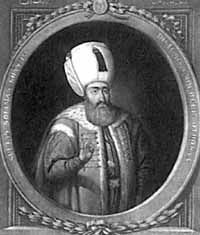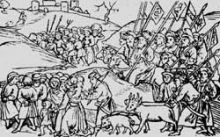Born in 1495 by a Serb concubine, Suleiman was in many respects opposite to his father Selim I the Grim. While Selim was distinguished for wanton cruelty even to his next of kin, his son Suleiman, who radically changed the direction of Turkish Ottoman invading expeditions (opting for the European vector, to use modern parlance), is equally well-known as an outstanding lawgiver (Kanuni in Turkish). Suleiman I drew up codes to streamline the military, administrative, and financial setup, and built such an integrated system of public administration that after his death Turkish sultans would only issue “decrees of justice” (adaletname), not laws. Suleiman I was largely responsible for the blossoming of Turkish culture that incorporated the best cultural traditions of the conquered nations; he also composed verse, patronized mathematicians, astronomers, cartographers, and seafarers. It was during his reign that the outstanding architect Sinan created his most famous and splendid mosques Selimiye, Shah-zadeh, and Suleimaniye.
By 1520 Turkey had literally been overcrowded with hundreds of thousands of Greek, Serb, Croatian, Albanian, and other slaves. Most of them were brought to the markets of Istanbul, Trebizond, Sinop, Caffa (now Feodosiya), and Alexandria of Egypt from the empire’s northern frontiers, with Crimean Tatars, who had come to the Crimea on the crest of the Tatar-Mongol invasion, being the principal suppliers of captives. Vassals of the Grand Duchy of Lithuania since 1420, the Girey dynasty khans presented no danger to the neighboring Ukrainians, Lithuanians, Poles, and Moldavians for another few decades (in 1429 the khan took a most active part in the anti-Ottoman congress in Lutsk).
But everything changed in 1457, when an Ottoman Turkish force landed near Caffa and captured, one by one, the Genoese fortresses of Caffa, Soldaya (now Sudak), and Balaklava. Aided by the Turks, the Crimean Tatars routed the Hellenic principality of Theodoro, the last fragment of Byzantine influence in the Crimea. Having seized the most important fortresses in the southern Crimea, the Ottoman Turks channeled the drive of their new vassals, who shared their Muslim faith, to the north: Khan Mengli-Girey began expeditions across the Perekop as early as in the 1480s. Mykhailo Hrushevsky wrote in his Illustrated History of Ukraine (Kyiv-Lviv, 1913), “Trying to set Mengli-Girey against the Grand Duchy of Lithuania, Moscow kept sending him generous gifts, and he soon began to devastate the Ukrainian lands that belonged to the Grand Duchy of Lithuania and Poland.”
Eminent Ukrainian Turkologist Ahatanhel Krymsky noted in his History of Turkey, “Polish historians say that ‘the Turk kept the Crimean Horde at the ready, as a hunter keeps at the ready his pack of hounds’ to be set loose and sicked on whomever he chooses at any moment. Thus these Crimean hounds could always bring their Turkish master rich human booty from Ukraine.”
It was to defend the Ukrainian lands from the marauding forays of Islamic warriors that a new community emerged in the lower Dnipro side as early as in the 1520s: the Cossacks, “natural successors to old Kyivan heroes who performed exploits, fighting against the steppe invaders on the frontier outposts” (Ahatanhel Krymsky). No doubt, the emergence of an Orthodox military community was not only a reaction to Turkish and Tartar forays but also a protest against ethnic and religious oppression in the Polish-Lithuanian Commonwealth (Rzeczpospolita).
The Crimean Tatar hordes most often attacked the towns and villages of Podillia, the Kyiv region, Galicia, Volhynia, and the Cherkasy region. Thousands of people were carried away in captivity by land, except for the most attractive women. Consider what foreigners wrote about sixteenth century captives: the Belgian Augier Busbecque (1554) and the Englishman George Sandy compared a file of slaves with horses at a fair; the Lithuanian diplomat and writer Mikhail Litvin, a contemporary of Suleiman I the Magnificent, noted, “When slaves are being taken out for sales, they are being led to a public square in a long file, one by one, as if they were a sedge of cranes, in groups of ten chained to each other by the neck. They are also sold in the batches of ten from an auction. The auctioneer cries out that these are new slaves, not yet injured and not too wise, just brought from the Royal, not Muscovite, land.”
In 1527 the vizier of Suleiman I the Magnificent said to Transylvanian Ambassador Hieronym Laski, “Although we do not fight against Poland (for we signed a truce with it), we have still exacted a 50,000-ducat tribute from it in the past few years by way of the Tatars, not by ourselves. The Tatars sell to Turkey the slaves they capture in Polish lands, which our customs offices cash in on. It is for two years that the Kiliya and Caffa customs offices have been making a profit 30,000 ducats more than usual.”
Of course, the captives had different destinies. Many worked in gardens, served merchants, a number of physically strong men were sent to the galleys, where they were chained to the bunks day and night and mercilessly beaten by overseers. Physically fit Ukrainian boys were usually settled in Turkish families and specialized schools, where they were taught the canons of Islam and made to do all kinds of work. They would become janissaries by the age of 18- 20. Deprived of family and kindred ties, these people were indispensable for the sultan to keep his empire in order. The Christian-born janissaries were “the Ottoman dynasty’s hand and wing” from the late fourteenth century until 1826, when the corps was disbanded.
The duma (sorrowful song) “Lament of the Captives” (recorded in 1904) vividly describes scenes in the life of our fellow countrymen who got into unbearable conditions:
“In Constantinople, at a bazaar,
will Turkish janissaries and highwaymen raid.
Will they sell us beyond the Red Sea into slavery?
Will they pay for us with silver,
gold, and unmeasured pieces of costly cloth?...
Unbearable slavery befell t he poor captives;
The iron shackles ate away the flesh of legs down to the yellow bones,
Bleeding white was the young Cossack’s body...”
The Ottoman Turks made breathtaking strides in the first half of the sixteenth century: Belgrade was seized in 1521, the Knights of Malta (Knights of St. John) evacuated the Isle of Rhodes the next year, the Hungarian army was routed in 1526 in the Battle of Mohacs (with Transylvanian Duke Jan Szapolyai ascending the Buda throne as King John I), Algeria and Tunisia opted to be the sultan’s vassals after Turkey had waged years of war against the Spanish Habsburgs.
In 1520, when a khan’s horde went on a rampage in Rohatyn and its environs in Opillia (now Ivano- Frankivsk oblast) and thousands of captives were taken to the markets of Istanbul, Caffa, and Trebizond, a seemingly unimportant event occurred: 15 year-old Anastasiya, daughter of Orthodox priest Havrylo Lisovsky, became the concubine of a Greek-born rich nobleman Ibrahim- Pasha. Greatly astonished by the fact that the charming slave girl knew Latin and Greek, he decided to present her to the sultan. In the harem (called the gate of bliss), Roxolana, as she was called to emphasize her Ruthenian, that is, Ukrainian origin, very soon gained favor with Suleiman I who entered into an official marriage with her, now converted to Islam, in 1523, which resulted in the birth of five children, a daughter and four sons. Roxolana was given the name of Hurrem (one who laughs) and pronounced bash-kaduni, the sultan’s chief wife. Suleiman I addressed her only as “my Haseki” (my sweetheart). The Venetian ambassador in Istanbul wrote that she was “pretty, modest, and knows very well the nature of her master.” Yet, mores were very cruel in the sultan’s palace, and Roxolana cared, of course, about her own destiny and the future of her children. Ibrahim-Pasha (appointed grand vizier in 1523), who knew her past as a slave girl and contributed to her elevation, at a certain point overestimated his influence on Suleiman I and was summarily executed in 1536.
But the greatest danger for the Ukrainian lady emanated from Mustafa, the sultan’s eldest son. His mother, a Circassian, ceded the chief-wife status to Roxolana but was still carrying on intrigues, trying to make Mustafa heir to the throne. In 1553 Roxolana managed to weave an intricate web of a plot, as a result of which the son of her ill-fated rival was accused of treason and executed.
Roxolana died around the late 1550s, failing to reach even fifty, survived by the sultan. Her husband died a natural death during the siege of the Hungarian fortress of Szigetvar in 1566. Two sons of Roxolana and Suleiman I died young, one was strangled on his father’s order, while Hurrem’s first-born became sultan known as Selim II. Dubbed Drunkard by the people, he was a dissolute rake who always evoked unpleasant memories. Historians hold him responsible for touching off the decline and fall of the Sublime Porte.
Anastasiya-Roxolana was buried in an eight-sided sepulcher by an Istanbul mosque. She achieved her goal, enabling Selim to take advantage of the bloody inheritance law and become sultan. Yes, the mores of the sultan’s palace were truly harsh, and the sixteenth century went down in history not only as an age of great discoveries, reformers, and scientists but also as one of horrible crimes, where the name of Nicolaus Copernicus, Titian, Nostradamus, FranНois Rabelais, and Martin Luther go hand in hand with those of Ivan the Terrible, Hernando Cortes, Francisco Pizarro, and Philip of Spain. Let us also recall the St. Bartholomew’s Day Massacre in 1572 and Catholic Inquisition burnings on the main squares of European cities. Only then will we perhaps be able to understand at least a little the sultan’s wife born and raised in Rohatyn, now Ivano-Frankivsk oblast.








